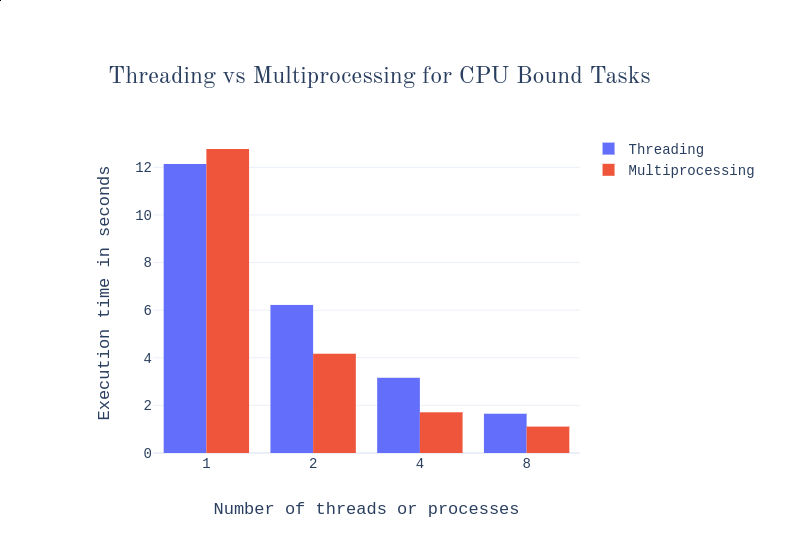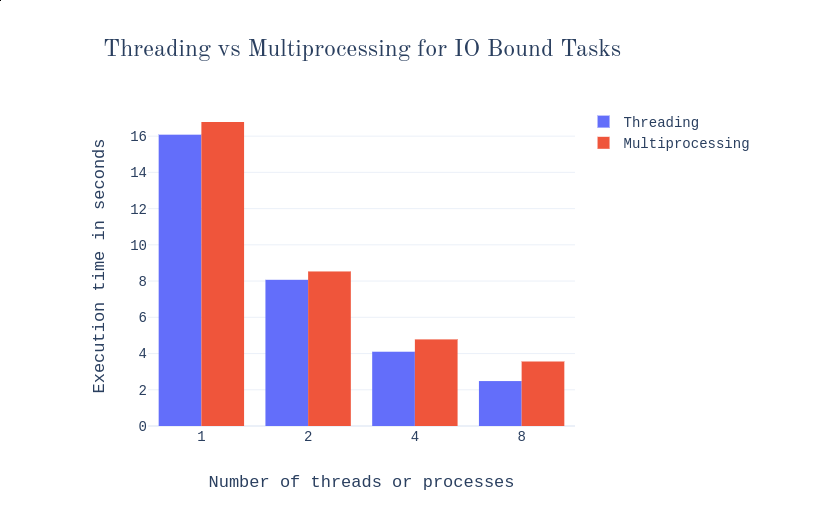serhii.net
In the middle of the desert you can say anything you want
-
Day 791 (01 Mar 2021)
Day 790
python3.7
..exists, and in general I should pay more attention to the new python versions and their changes.
tiffsplit
Ubuntu Manpage: tiffsplit - split a multi-image TIFF into single-image TIFF files
Installs as
libtiff-tools, basename can be used as prefix.
-
Day 790 (28 Feb 2021)
Day 789
Inkscape joining (union) of paths
When joining/adding two paths (as in discrete math union) located in different layers, the resulting path will be located in the layer selected when doing the joining.
Inkscape groups
.. are recursive! Grouping two groups works; ungrouping them leads the original two groups!
-
Day 788 (26 Feb 2021)
Day 787
Python multiprocessing/threading basics
From Multiprocessing vs. Threading in Python: What Every Data Scientist Needs to Know
Terminology:
-
Processes: instances of a program being executed; don’t share memory space
- Slower to create, take a bit more memory and stuff
-
Threads: components of a process that run in parallel; share memory, variables, code etc.
- Faster to create, less overhead
- Much easier to share objects between them
-
Race Condition: “A race condition occurs when multiple threads try to change the same variable simultaneously.” (Basically - when order of execution matters)
-
Starvation: “Starvation occurs when a thread is denied access to a particular resource for longer periods of time, and as a result, the overall program slows down.”
-
Deadlock: A deadlock is a state when a thread is waiting for another thread to release a lock, but that other thread needs a resource to finish that the first thread is holding onto.
-
Livelock : Livelock is when threads keep running in a loop but don’t make any progress.
Python / GIL
In CPython, the Global Interpreter Lock (GIL) is a (mutex) mechanism to make sure that two threads don’t write in the same memory space.
Basically “for any thread to perform any function, it must acquire a global lock. Only a single thread can acquire that lock at a time, which means the interpreter ultimately runs the instructions serially.” Therefore, python multithreading cannot make use of multiple CPUs; multithreading doesn’t help for CPU-intensive tasks, but does for places where the bottleneck is elsewhere - user interaction, networking, etc. Multithreading works for places w/o user interaction and other bottlenecks where the tasks are CPU-bound, like doing stuff with numbers.
Tensorflow uses threading for parallel data transformation; pytorch uses multiprocessing to do that in the CPU.
TODO - why does Tensorflow do that?
Python libraries
Python has two libraries,
multithreadingandmultiprocessing, with very similar syntax.Comparing execution time
Both pictures from the same article above1:


- One process is slower than one thread always; for more than one, processes win for CPU-only tasks, threads for bottlenecked tasks.
- More processes than cores doesn’t improve life by much in any case (still better than the same amount of threads though); in the picture, there are four cores.
Python-specific points
- Easier to make errors in multithreading programs (easier to share data, but you have to keep in mind object synchronisation and race conditions).
- Threads can’t do true parallelism in Python due to GIL
- The OS schedules processes, Python schedules threads
- “Child processes are interruptible and killable, whereas child threads are not. You have to wait for the threads to terminate or join.”
For data science
- Reading data from disk is I/O bound => multithreading
- Calculating stuff on CPU/GPU is CPU bound => multiprocessing
- Storing results => multithreading
Concurrency / parallelism / Python
From Python Multi-Threading vs Multi-Processing | by Furqan Butt | Towards Data Science:
Concurrency is essentially defined as handling a lot of work or different units of work of the same program at the same time.
Doing a lot of work of the same program at the same time to speed up the execution time.
Parallelism has a narrower meaning.
Python -
concurrent.futuresfor multithreading and multiprocessingMultithreading:
import concurrent.futures with concurrent.futures.ThreadPoolExecutor() as executor: executor.map(function_name, iterable)This would create a thread for each element in
iterable.Multiprocessing works in an extremely similar way:
import concurrent.futures with concurrent.futures.ProcessPoolExecutor() as executor: executor.map(function_name, iterable)More about it, as usual, in the docs:
The asynchronous execution can be performed with threads, using ThreadPoolExecutor, or separate processes, using ProcessPoolExecutor. Both implement the same interface, which is defined by the abstract Executor class. 2
Questions
Does
concurrent.futureshave any tradeoffs compared to doingmultiprocessing.Pool()like the following?pool = multiprocessing.Pool() pool.map(multiprocessing_func, range(1,10)) pool.close()Measuring and reading time
Python parallelism example
Parallelising Python with Threading and Multiprocessing | QuantStart has a nice point:
time python thread_test.pyreal 0m2.003s user 0m1.838s sys 0m0.161sBoth
userandsysapproximately sum to therealtime. => No parallelization (in the general case). After they use multiprocessing, two processes,realtime drops by two, whileuser/systime stays the same. So time on CPU per second is the same, but we have two CPUs that we use, and we get real time benefits.Reading and interpreting
timeoutput:Excellent article, copying directly: Where’s your bottleneck? CPU time vs wallclock time
real: the wall clock time.user: the process CPU time.sys: the operating system CPU time due to system calls from the process.In this case the wall clock time was higher than the CPU time, so that suggests the process spent a bunch of time waiting (58ms or so), rather than doing computation the whole time. What was it waiting for? Probably it was waiting for a network response from the DNS server at my ISP.
Important: If you have lots of processes running on the machine, those other processes will use some CPU.
Reading CPU time ratios
Directly copypasting from the article above, “CPU” here is “CPU Time” (so
userin the output of the command), second is “real” (=wall; real-world) time.If this is a single-threaded process:
- CPU/second ≈ 1: The process spent all of its time using the CPU. A faster CPU will likely make the program run faster.
- CPU/second < 1: The lower the number, the more of its time the process spent waiting (for the network, or the harddrive, or locks, or other processes to release the CPU, or just sleeping). E.g. if CPU/second is 0.75, 25% of the time was spent waiting.
If this is a multi-threaded process and your computer has N CPUs and at least N threads, CPU/second can be as high as N.
- CPU/second < 1: The process spent much of its time waiting.
- CPU/second ≈ N: The process saturated all of the CPUs.
- Other values: The process used some combination of waiting and CPU, and which is the bottleneck can be harder to tell with just this measurement.
A bit more about cpu time
- The user-cpu time and system-cpu time [..] are the amount of time spent in user code and the amount of time spent in kernel code. 3
- multi-core machines and multi-threaded programs can use more than 1 CPU second per elapsed second 3
Python-specific thread programming:
- Examples of race-conditions and using locking: Multithreading in Python | Set 2 (Synchronization) - GeeksforGeeks
- TL;DR:
def thread_task(lock): """ task for thread calls increment function 100000 times. """ for _ in range(100000): lock.acquire() increment() lock.release()- Examples of sharing data in multiprocessing (didn’t read, TODO): Multiprocessing in Python | Set 2 (Communication between processes) - GeeksforGeeks
- As usual, details (including sharing state etc):
-
-
Day 787 (25 Feb 2021)
Day 786
ELIZA chatbot source
This is the script of the DOCTOR program for ELIZA: eliza/doctor.txt at master · wadetb/eliza
SSH port forwarding - you can forward multiple ports!
The -L option can be specified multiple times within the same command. Every time with different ports. 1
Here’s an example:
ssh me@remote_server -L 8822:REMOTE_IP_1:22 -L 9922:REMOTE_IP_2:22And an even better solution from there, adding this to
~/.ssh/configHost port-forwarding Hostname remote_server User me LocalForward 6007 localhost:6007 LocalForward 6006 localhost:6006 Port 10000and then just do
ssh pf!Latex color list
A list of all colors in latex supported via the various packages: color - Does anyone have a newrgbcolor{colourname}{x.x.x} list? - TeX - LaTeX Stack Exchange
-
Day 786 (24 Feb 2021)
Day 785
Jupyter notebook - show token
Pressing
<Ctrl-C>in a Terminal where jupyter-notebook is running will show a list of running kernels/notebooks, which will include the token:1 active kernel Jupyter Notebook 6.2.0 is running at: http://localhost:6007/?token=3563b961b19ac50677d86a0952c821c2396c0255e97229bc or http://127.0.0.1:6007/?token=3563b961b19ac50677d86a0952c821c2396c0255e97229bcmAP (mean average precision) metric
Nice description: Measuring Object Detection models - mAP - What is Mean Average Precision?
TL;DR a way to uniformly calculate results of object detection over an entire dataset, accounding for different thresholds (“my 50% confidence is your 80%). We get such thresholds that recall is 0.1, 0.2, …, 1.0 and then measure precision at these points; take the mean.
A bit more details: rafaelpadilla/Object-Detection-Metrics: Most popular metrics used to evaluate object detection algorithms.
-
Day 785 (23 Feb 2021)
Day 784
Force unmount / umount
One can use
mountwithout arguments to get the list of mounted filesystems! oKilling anything that uses a directory:1
fuser -kim /address # kill any processes accessing file unmount /address(
-kis kill,-iis “ask nicely before killing”)Reproducibility / configs / experiments / yacs
rbgirshick/yacs: YACS – Yet Another Configuration System is a “lightweight library to define and manage system configurations, such as those commonly found in software designed for scientific experimentation”. It’s used by detectron2, serializes configs in yaml files. Nicely supports standard settings and experiment overrides and CLI overrides. Basically what I’ve been trying ot hack together in some of my scripts.
Detectron2 error with test set when none set.
Got:
FileNotFoundError: [Errno 2] No such file or directory: 'datasets/coco/annotations/instances_val2017.jsonat the end of trainings.Solution was to have
cfg.DATASETS.TEST = ()explicitly set, not commented out like I had. 2so it’s a mystery why
cfg.DATASETS.TESTis looking fordatasets/coco/annotations/instances_val2017.jsonIndeed.
Detectron2 evaluation
Example of how to use EvalHook to run functions: detectron2/train_net.py at master · facebookresearch/detectron2 (but I’d like to implement the eval as a subclass)
-
Day 784 (22 Feb 2021)
Day 783
Python to read
Python path / pathlib
The python3 way to work with paths seems to be pathlib — Object-oriented filesystem paths — Python 3.9.2 documentation, not the old
os.path.*Split is Path (close to really-existing things), and PurePath - abstract paths, without connection to any real filesystem.
-
Day 780 (18 Feb 2021)
Day 779
Python working with shapes
Shapely is awesome! And easy to play with in jupyter notebook
SSH port forwarding for tensorboard/jupyter
To access a Tensorboard (..or anything) running on a remote server
servernameon port 6006:ssh -L 6006:127.0.0.1:6006 me@servernameAfter this, tensorboard is bound to the local port 6006, so
127.0.0.1:6006.Tensorboard has to be run with
--host=127.0.0.1to make it accessible from outside.Jupyter - the link with the token can simply be followed (or copypasted), if the port is the same in both localhost and server.
-
Day 778 (16 Feb 2021)
Day 777
matplotlib/pyplot invert/reverse axis
Unsurprisingly intuitive:
ax.set_ylim(1, 0)(of course, problematic if you don’t know your actual limit)
EDIT Mi 10 Mär 2021 19:23:20 CET: There’s an even better solution! 1
ax.invert_yaxis()Install pytorch on CUDA 10.0 + verify torch/cuda installation
Pytorch officially doesn’t do CUDA 10.0.x, but I found this, worked perfectly: How to Install PyTorch with CUDA 10.0 - VarHowto
Installing:
pip install torch==1.4.0 torchvision==0.5.0 -f https://download.pytorch.org/whl/cu100/torch_stable.htmlTesting installation and GPU:
import torch x = torch.rand(5, 3) print(x) torch.cuda.is_available()
-
Day 777 (15 Feb 2021)
Day 776
Dotfiles over multiple servers
Nice discussion: How do you manage your dotfiles across multiple and/or new developer machines? - DEV Community
This article also provides a really nice explanation of the general practice that many people seem to be taking: store dotfiles in GitHub, and then install them via a simple script that symlinks files and runs any additional init logic.